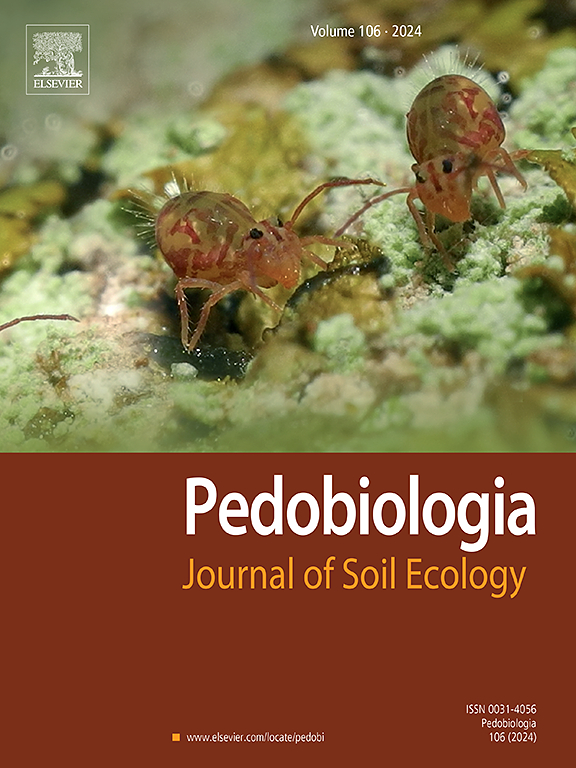Trichoderma guizhouense enhances tomato (Solanum lycopersicum) Ralstonia wilt suppression by organic fertilizer, focusing on rhizosphere soil bacterial community
IF 2.2
3区 农林科学
Q3 ECOLOGY
引用次数: 0
Abstract
Trichoderma guizhouense is recognized as an effective antagonistic fungus against Ralstonia solanacearum, the causative agent of tomato bacterial wilt. However, how T. guizhouense-enriched organic fertilizer affects the survival of R. solanacearum and bacterial community in tomato rhizosphere soil is still poorly understood. To address this, a pot experiment was conducted to assess changes in the abundance of the fliC gene (a marker for R. solanacearum) and to investigate shifts in the rhizosphere bacterial community after T. guizhouense-enriched organic fertilizer application using quantitative PCR and high-throughput sequencing, respectively. The results showed that T. guizhouense-enriched organic fertilizer application significantly reduced the abundance of fliC gene in tomato rhizosphere soil after 15 days of R. solanacearum inoculation, and notably decreased the disease index of tomato wilt after 13 days of R. solanacearum inoculation (P < 0.05). Compared to common organic fertilizer application alone, T. guizhouense-enriched organic fertilizer application significantly increased the Shannon index of soil bacterial community and enhanced the relative abundance of beneficial bacterial genera, including Caulobacter, Chitinophaga and Bacillus. Both T. guizhouense-enriched organic fertilizer application and R. solanacearum inoculation significantly altered soil bacterial community composition. Moreover, the bacterial co-occurrence network exhibited greater complexity and cohesiveness in the T. guizhouense-enriched organic fertilizer application treatment, which could contribute to maintaining the stability of rhizospheric bacterial community of R. solanacearum-infected tomato. The findings suggested that T. guizhouense-enriched organic fertilizer would significantly suppress bacterial wilt and changed the bacterial community structure of the soil.
有机肥增强贵州木霉对番茄枯萎病的抑制作用,重点关注根际土壤细菌群落
贵州木霉是一种有效的拮抗番茄青枯病病原菌。然而,目前对富贵州赤霉素有机肥对番茄根际土壤番茄枯枯菌存活及细菌群落的影响尚不清楚。为了解决这一问题,本研究采用盆栽试验方法,分别利用定量PCR和高通量测序技术,研究了施用贵州稻富有机肥后植株根际细菌群落的变化,以及fliC基因(番茄红霉的标记物)丰度的变化。结果表明,施用贵州赤霉素富有机肥可显著降低接种15 d番茄根际土壤flc基因丰度,显著降低接种13 d番茄枯萎病指数(P <; 0.05)。与单独施用普通有机肥相比,施用贵州土肥显著提高了土壤细菌群落的Shannon指数,提高了Caulobacter、Chitinophaga和Bacillus等有益菌属的相对丰度。施用富含贵州赤霉素的有机肥和接种茄青霉均显著改变了土壤细菌群落组成。富贵州赤霉病有机肥处理的细菌共生网络表现出更大的复杂性和内聚性,有助于维持番茄赤霉病根际细菌群落的稳定性。综上所述,富贵州土有机肥能显著抑制青枯病,改变土壤细菌群落结构。
本文章由计算机程序翻译,如有差异,请以英文原文为准。
求助全文
约1分钟内获得全文
求助全文
来源期刊

Pedobiologia
环境科学-生态学
CiteScore
4.20
自引率
8.70%
发文量
38
审稿时长
64 days
期刊介绍:
Pedobiologia publishes peer reviewed articles describing original work in the field of soil ecology, which includes the study of soil organisms and their interactions with factors in their biotic and abiotic environments.
Analysis of biological structures, interactions, functions, and processes in soil is fundamental for understanding the dynamical nature of terrestrial ecosystems, a prerequisite for appropriate soil management. The scope of this journal consists of fundamental and applied aspects of soil ecology; key focal points include interactions among organisms in soil, organismal controls on soil processes, causes and consequences of soil biodiversity, and aboveground-belowground interactions.
We publish:
original research that tests clearly defined hypotheses addressing topics of current interest in soil ecology (including studies demonstrating nonsignificant effects);
descriptions of novel methodological approaches, or evaluations of current approaches, that address a clear need in soil ecology research;
innovative syntheses of the soil ecology literature, including metaanalyses, topical in depth reviews and short opinion/perspective pieces, and descriptions of original conceptual frameworks; and
short notes reporting novel observations of ecological significance.
 求助内容:
求助内容: 应助结果提醒方式:
应助结果提醒方式:


